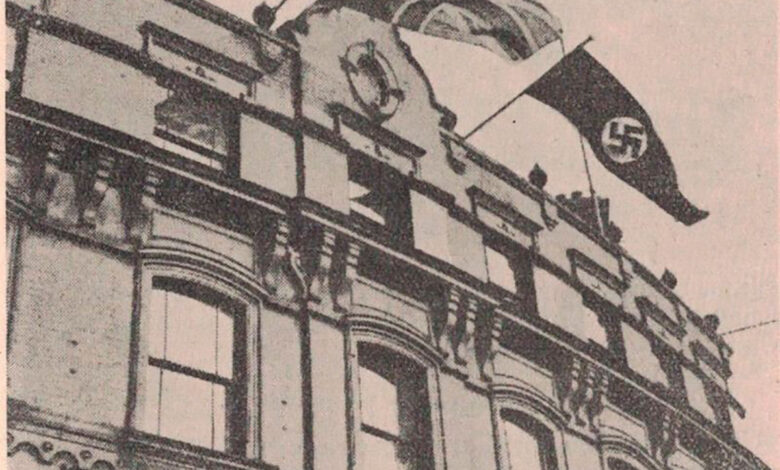The day the Nazi swastika flew across the UK


The photograph was printed in a Nazi propaganda newspaper.
Photo: STUTTGART POLICE / copyright
The blurred image of a newspaper may be the only record of the time the UK flag and the Nazi swastika flew together on British soil.
The photograph, discovered recently, was taken during a visit of a German boxing team to the English city of Nottingham in October 1936.
Despite the increase in tension between the two countries, visits between groups and societies were common.
“It’s quite chilling to see the two flags side by side,” says historian Tom Andrews.
Flags flew together in front of the now demolished County Hotel to welcome Germany’s Stuttgart Police Boxing Club.

Despite the First World War, United Kingdom maintained strong ties with Germany, even after Hitler took over and became more belligerent.
The desire to support these links led to a series of events that, in hindsight, are discordant.
This included the fact that a swastika flew over the White Heart Lane football field in 1935 and, perhaps most infamously, andl England football team dodo the Nazi salute in Berlin in 1938.
“We often forget how cordial relations were between Britain and Germany. There was an Anglo-German camaraderie, ”says Professor Julie Gottlieb, an expert in modern history.
“The two countries were trading partners until 1939. But I can’t think of another example where the two flags flew side by side in the UK.”
Andrews has investigated Nottingham’s wartime police chief Athelstan Popkess.

“Popkess was interested in having his officers play sports, especially boxing, and compete against other police teams,” Andrews notes.
“This resulted in a goodwill visit to the Stuttgart police, and the Nottingham team moved to Germany first.”
“I had heard accounts of the two flags flying together but I didn’t think there were any photos.”
Upon hearing the story, an Andrews contact went through the Stuttgart police files.
“He found the photo but didn’t know what building it was in, so I tracked down the location,” adds Andrews.
“It is quite chilling to see the two flags flying side by side three years before the war broke out.”
“But Popkess saw the militarization of Germany and that led him to organize precautions against air strikes in Nottingham, which became an example for many cities to follow.”

The visit was used for propaganda purposes by the Nazis and an accompanying article reported how the town sheriff had encouraged Hitler and that the hosts gave the Nazi salute when the German national anthem was played.
But Gottlieb says these actions need to be seen in context.
“The swastika didn’t have the same impact then as it does now,” he says.
“But you didn’t have to look very far to see the evidence of what the Nazis were like, especially with the Nuremberg laws and the persecution of minorities,” he highlights.
Britain had its own far-right party, led by the fascist Oswald Mosley.
The British Union of Fascists (UBF) had 50,000 members in the early 1930s and was involved in various public disturbances.
But they never used the swastika. As an ultra-nationalist and patriotic movement, they used the British flag, ”says Gottlieb.
“When, in the mid-1930s, the UBF was aligning itself more with the Nazis, it changed its own symbol to a flash in a circle, giving them the nickname ‘flash in the pan.’
But they were never really a major political force. The greatest concern centered on the fascist tendencies in the government ”.
“The organization was more willing to give Hitler the benefit of the doubt, and appeasement was the expression of this. But after ‘the night of broken glass’ in November 1938, there were few public defenders of the Nazis, ”concludes Gottlieb.
Now you can receive notifications from BBC News Mundo. Download the new version of our app and activate them so you don’t miss out on our best content.
.



